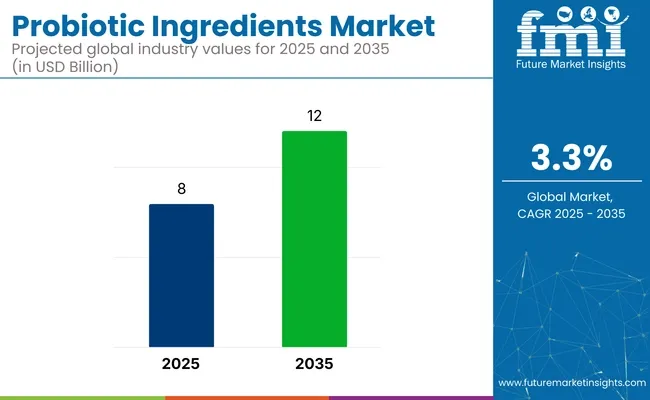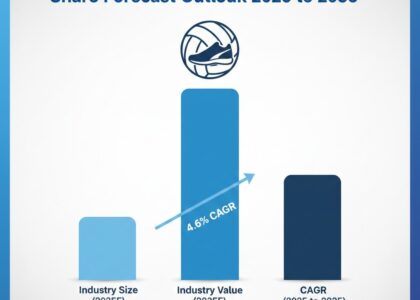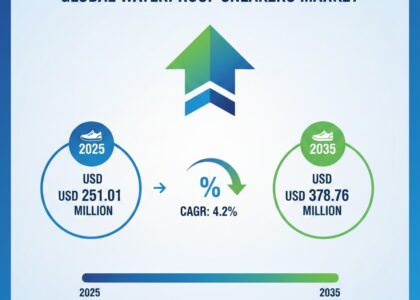
You can find them everywhere now — in yogurt, sparkling water, protein powders, snack bars, even pet treats. Probiotics have moved from the margins of alternative health into the very core of mainstream wellness. But as this multi-billion-dollar industry expands, a bigger question is brewing: Are probiotic ingredients truly making us healthier — or just selling us better narratives?
According to Future Market Insights, the global probiotic ingredients market is expected to grow from USD 8 billion in 2025 to USD 12 billion by 2035, reflecting a compound annual growth rate (CAGR) of 3.3%. Bacterial strains — especially those derived from the Lactobacillus and Bifidobacterium families — are projected to make up 75% of the total market share by product type.
The food and beverage sector is expected to account for 40% of the end-use market, and powders will dominate in product form, holding 45% of the market in 2025. These figures signal more than just business growth — they reflect a cultural obsession with gut health that may be outpacing the science behind it.
Access Key Market Insights: Request a Sample Report Now: https://www.futuremarketinsights.com/reports/sample/rep-gb-9608
From Cultures to Capital: The Rise of Probiotic Everything
Probiotic-enhanced products now span nearly every consumer category, from functional beverages to plant-based meats, infant formulas, and digestive health supplements. Some of it is innovation. Much of it is opportunism.
What began as a legitimate health frontier — improving the gut microbiome to support digestion, immunity, even mood — has in many ways morphed into a trillion-cell solution for every health concern. Whether that solution actually delivers measurable results remains highly inconsistent across products.
Yet the trend barrels forward. The market rewards any brand that can splash “live cultures” on a label. And the powder format — which FMI predicts will hold nearly half the market — makes formulation easy, shelf-stable, and scalable. It also raises questions about whether those organisms survive manufacturing, storage, and the digestive tract.
Heightened Market Interest: Our Complete Report Delivers Extensive Analysis and Trends: https://www.futuremarketinsights.com/reports/probiotic-ingredients-market
A Market Growing Faster Than the Evidence
With food and beverage applications making up a projected 40% of demand, there’s little doubt that probiotics have been fully absorbed into the daily diet of health-focused consumers. But does that mean consumers are better off?
In many cases, what’s being consumed is not a targeted therapeutic — but rather a generalized promise of wellness. Products vary widely in strain selection, dosage, and efficacy. And without clear, enforceable standards, the industry has created an echo chamber of health claims.
Despite this, the sector keeps expanding — thanks in part to convenience, consumer psychology, and global demand for gut-friendly solutions that feel natural, non-invasive, and holistic.
The Global Stakes
Probiotic ingredients aren’t just a trend in the West. In global food and nutrition systems, they’re also being used to fortify staples and tackle digestive health at a population level. Whether in yogurts, instant mixes, or nutraceuticals, probiotics are being adapted to regional diets and health challenges — often as a low-cost tool to improve digestive and immune health.
But no matter the geography, the core question remains the same: Do these products deliver consistent health outcomes? Or are they just riding the wave of microbiome marketing?
Looking Ahead: From Hype to Accountability
As the probiotic ingredient market matures, its future will depend on more than just creative formulations. It will require credible science, responsible branding, and regulatory clarity. Consumers will increasingly demand strain-specific benefits, clinical relevance, and transparent labeling.
Until then, the category sits in a peculiar space: growing rapidly, selling optimism, and teetering between groundbreaking and overblown.
Probiotics may well hold enormous potential — but the next chapter of this market needs to be built not on vague claims, but on verifiable health outcomes. Only then will this $12 billion industry truly earn its place at the center of the modern food and health conversation.
Key Players in the Probiotic Ingredients Market
- BioGaia AB
- Sabinsa Corporation
- Lallemand, Inc.
- LeSaffre, S.A.
- Probi AB
- DowDuPont Inc.
- Ganeden, Inc.
- Probiotics International Ltd.
- Novonesis Group
- Koninklijke DSM NV
Explore Functional Food Ingredients Industry Analysis: https://www.futuremarketinsights.com/industry-analysis/functional-food-ingredients
Probotic Ingredients Market Analyzed by Key Investment Segments
By Product Type:
Bacterial (Lactobacillus, Bacillus, Enterococcus, Bifidobacterium, Streptococcus, others) and yeast (Saccharomyces Cerevisiae, Saccharomyces Boulardii).
By End Use:
Food & beverages processing (bakery & confectionery, breakfast solutions, cultured dairy products, ice cream & frozen desserts, snacks & bars, infant nutrition, beverages & dairy drinks), Dietary supplements (immune health, gut & digestive health, women’s health), Personal care & cosmetics, and animal feed.
By Product Form:
Powder, suspension, granule, capsule, stick pack, tablet/chewable, and gel.
By Region:
North America, Latin America, Western Europe, Eastern Europe, Balkans & Baltic, Russia & Belarus, Central Asia, East Asia, South Asia & Pacific, and Middle East & Africa.





